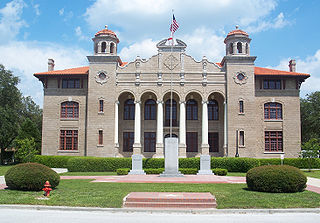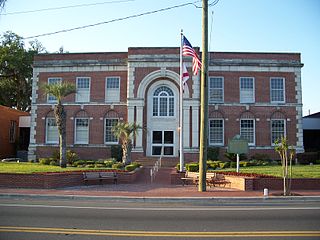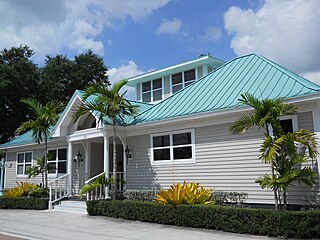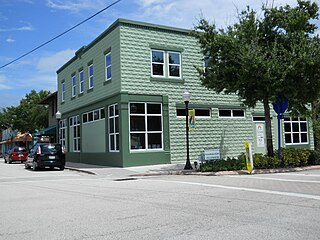
Martin County is a county located in the Treasure Coast region in the state of Florida, in the United States. As of the 2010 census, the population was 146,318. Its county seat is Stuart.

The Old Martin County Court House, built in 1937, is an historic Art Deco style courthouse building located at 80 East Ocean Boulevard in Stuart, Martin County, Florida. In 1989, it was listed in A Guide to Florida's Historic Architecture, published by the University of Florida Press. On November 7, 1997, it was added to the U.S. National Register of Historic Places. On March 15, 2007, it was added to the Martin County Historic Register by the Martin County Historic Preservation Board. It is now known as the Courthouse Cultural Center and is the headquarters of the Arts Council, Inc., the designated local arts agency for Martin County.

The Sumter County Courthouse, built in 1912-1914, is an historic courthouse building located in Bushnell, Florida. The total costs of construction for the courthouse were $56,000. It was designed by Atlanta-based architect William Augustus Edwards who designed one other courthouse in Florida, two in Georgia and nine in South Carolina as well as academic buildings at 12 institutions in Florida, Georgia and South Carolina. He designed most of the original buildings on the campus of the University of Florida in Gainesville. In 1989, The Sumter County Courthouse was listed in A Guide to Florida's Historic Architecture, published by the University of Florida Press.

The Glades County Courthouse is an historic courthouse building located at 500 Avenue J in Moore Haven, Florida. Built in 1928 in the Classical Revival style, it was designed by Georgia-born American architect Edward Columbus Hosford, who is noted for the courthouses and other buildings that he designed in Florida, Georgia and Texas.

The Madison County Courthouse, built in 1913, is a historic courthouse building located in Madison, Florida. It is Madison County's fourth courthouse and the third built in Madison. The first log building at San Pedro was abandoned along with the town. The second courthouse built in 1840 in Madison burned in 1876 and was replaced by an 1880 brick structure which burned in 1912. The present building is unusual among Florida courthouses of its vintage in never having been added onto or expanded. In 1989, the Madison County Courthouse was listed in A Guide to Florida's Historic Architecture, published by the University of Florida Press.

The Washington County Courthouse was an historic brick courthouse building located in Chipley, Florida. It was built in 1932 in the Classical Revival style after Chipley won a 1927 referendum to move the county seat from Vernon

The Old Gulf County Courthouse is a historic redbrick courthouse building located at 222 North 2nd Street in Wewahitchka, Florida. It was built in 1927 in the Classical Revival style after Wewahitchka was designated the county seat of newly created Gulf County. In 1965 the county seat was moved to Port St. Joe and a new courthouse was built there. The old courthouse still functions as an auxiliary to the Port St. Joe courthouse.

The Union County Courthouse is an historic redbrick courthouse building located in Lake Butler, Florida. Designed by John Pearson of Gainesville in the Classical Revival style, it was built in 1936 by the Works Project Administration to serve Union County, which had been carved out of Bradford County in 1921. It is located on the site of a former courthouse that served the county of New River, Bradford's original name. In 1967 additions to the courthouse were designed by Harry E. Burns, Jr., and were built by Vinson J. Forrester, Jr.

The Old Flagler County Courthouse is an historic two-story redbrick courthouse building located at 200 East Moody Boulevard in Bunnell, Florida. Designed by Wilbur Talley in the Classical Revival style, it was built in 1924 by O. P. Woodcock to serve Flagler County which had been created in 1917. It was the county's second courthouse building and its first purpose built one. In 1985 a three-story addition was attached to its rear. In January 2007 the 1924 building was closed due to safety problems with its roof. By January 2008, the 1985 addition had also been vacated due to structural problems. Courthouse operations are now housed at the Kim C. Hammond Justice Center 1769 East Moody Boulevard.

The Old Charlotte County Courthouse is an historic two-story yellow brick courthouse building located at 227 Taylor Street in Punta Gorda, Florida, Florida. Designed in the Classical Revival style by architects Leitner and Henson of St. Petersburg, it was built between 1927 and 1928 by Paul H. Smith of Haines City. Additions were made to the building the 1960s and 1980s but in 1999 it was replaced by a new Justice Center and then fell into disuse. In 2005, the additions having been demolished, the Board of County Commissioners undertook the restoration and renovation of the original 1928 structure that remained. It was reopened to the public in a ceremony on February 29, 2008.

The Old Brevard County Courthouse, renamed in 2006 as the Vassar B. Carlton Historic Titusville Courthouse, is an historic courthouse building located at 506 South Palm Avenue in Titusville, Florida. Designed in the Classical Revival style, it was built in 1912 by Lightman, McDonald and Company to serve as Brevard County's first courthouse building erected in Titusville.

The Hardee County Courthouse, built in 1927, is an historic courthouse building located at 417 West Main Street in Wauchula, Florida. It was designed by architect H.G. Little of Wauchula in the Classical Revival style of architecture. Robertson Construction Co. was the builder. In 1989, the Hardee County Courthouse was listed in A Guide to Florida's Historic Architecture, published by the University of Florida Press.

The Columbia County Courthouse, built in 1905, is an historic courthouse building located at 173 NE Hernando Avenue in Lake City, Florida. It was designed by architect Frank Pierce Milburn in the Classical Revival style of architecture. It was built with a dome and cupola, which were removed before 1989, but were restored in 2003 during a major renovation and expansion of the courthouse. In 1989, the Columbia County Courthouse was listed in A Guide to Florida's Historic Architecture, published by the University of Florida Press.

The Dudley-Bessey House, also known as the Major Phillip B. H. Dudley Home, is an historic two-story, single-family house located at 110 SW Atlanta Avenue in Stuart in Martin County, Florida. Built in 1909 for Phillip B. H. Dudley, it features a first floor central hallway which runs from the street-side entrance straight though to the main entrance which faces the Halpatiokee River, now known as the South Fork of the St. Lucie River. All interior rooms open from this hallway. It later became home of Hubert W. Bessey, 1855–1918, one of the founders of Stuart, Sometime before 1989 the street side was altered by the addition of a long porch with a flat roof and a sloped roof over the entryway. Today most of the front porch has been enclosed and incorporated into the building, leaving only a sheltered entryway with a grander sloped roof over the entry way and hip roofs over the each side of the former porch. The interior has been restored and the building became the offices of United Yacht Sales.

The Nassau County Courthouse, also known as the Old Nassau County Courthouse and the Historic Nassau County Courthouse, is a historic two-story red brick courthouse building located at 416 Centre Street in Fernandina Beach, Nassau County, Florida. Designed in the Classical Revival style, it was built in 1891 and features cast-iron Corinthian columns and a massive bell tower and steeple. Meneely and Co. of West Troy, New York, cast the bell for the tower, which was used as a fire alarm for many years.

Woodmen Hall is an historic 2-story wooden Woodmen of the World building located 217 SW Akron Avenue, corner of SW 3rd Street in Stuart, Martin County, Florida. It was built between 1913-1914 by local master carpenter Sam Matthews. Like many fraternal buildings built in the late 19th century and early 20th century, the ground floor was designed for commercial use, while the upper floor was designed for use as a meeting room for Pineapple Camp No. 150, Woodmen of the World as well as community groups. Prominent members of Pineapple Camp include George W. Parks, who had a general store in what is now the Stuart Heritage Museum and in 2000 was added to the state's list of Great Floridians. Early users of the first floor include H.A. Carlisle's Feed Store. From the 1930s until 1959, Southern Bell used the first floor as a business office, while the Stuart telephone exchange was located on the second floor. Recent uses have included a church and a coffee house and open mic music venue. One group performing in it even calls itself, Woodmen Hall. The building has been recently renovated through the efforts of Stuart Main Street. An elevator has been added. The double outside staircases on the eastern part of the south side have been reduced to one, while an outside staircase has been added on the north side toward Akron Avenue. The two large front windows differ from those shown in a 1925 photograph. "

The Coca-Cola Bottling Plant is an historic one-story redbrick building located at 517 North Main Street in Trenton, Gilchrist County, Florida. Built in 1925, the building was listed in 1989 in A Guide to Florida's Historic Architecture, published by the University of Florida Press. At the time of its listing, it was "in disrepair and not in use." Today it has been renovated and is being used by the Suwannee Valley Quilt Shoppe and the Suwannee Rose Cafe.

The Feroe Building, also known as the Harry C. Feroe Building and the Stewart Building, is an historic two-story commercial building located at 73 S.W. Flagler Avenue, corner of S.W. St. Lucie Avenue in Stuart, Martin County, Florida. To its north of along Flagler Avenue is Fellowship Hall built in 1912 as the Bank of Stuart, while to the east along Flagler Avenue is the Lyric Theatre built in 1925 and later expanded. Built and named for Harry C. Feroe, who was associated with Charles C. Chillingworth in the development of Palm City, it was built in 1913 by local contractor Sam Matthews using locally manufactured concrete blocks which had been cast by Frank Frazier to look like stones. The ground floor, which fronted on St. Lucie Avenue and featured cast-iron columns, was designed for retail use, while the second floor, which was accessed by stairs from an entrance on the Flagler Avenue side of the building, was designed for office space. Later in 1913 the Florida East Coast Railway built its now demolished Stuart Depot directly across Flagler Avenue from the building, which enhanced its value. Early ground floor tenants were the Stuart post office in the corner space and the Stuart Drug Company to its north. After the post office moved out, its space was occupied by various other businesses until eventually being combined with the drug store space. Marilyn's Pharmacy, a Rexall agency, occupied the space in the 1960s and early 1970s. In the middle 1980s local lawyer Larry M. Stewart brought the building and renovated it for his law offices. The main entrance was moved to the east side of the building with access from a courtyard which is entered from Flagler Avenue through an arched wrought-iron gate.

The Capt. John Miller House is an historic wooden house at what is now 12387 South Indian River Drive, in St. Lucie County, Florida. Its mail comes from the Jensen Beach post office in nearby Martin County. Built by local pioneer Capt. John Miller beginning around 1889 and ending around 1901, it started as a two-room one-story house and ended up a ten-room two-story house with a cross-gabled roof. In 1989, it was listed in A Guide to Florida's Historic Architecture, published by the University of Florida Press.























